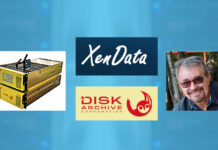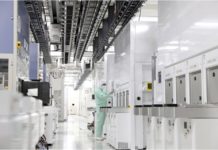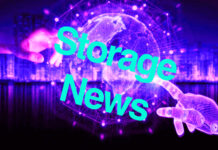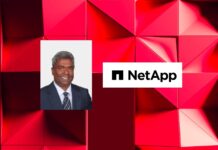Analysis: With the arrival of 122 TB SSDs, the case for disk drives being replaced by SSDs suddenly looks much more compelling.
At the end of 2024, we have five suppliers with 60 TB-plus SSDs and three with 122 TB SSDs announced: Micron, Phison, and SK hynix. Samsung has a 60 TB-plus SSD, while Kioxia and Western Digital languish behind this 60 TB-plus pack. How does this affect the argument that HDDs will not be replaced by SSDs?
This discussion is focused on prices, performance, datacenter rack numbers, and electricity usage. We can’t examine drive acquisition prices as the ones used for volume purchases by storage array OEMs and hyperscalers are not public. However, we can understand some cost indicators that affect drive ownership. To start, we compared a 2RU x 12-slot disk drive chassis with a 2RU x 24-slot SSD enclosure from Supermicro in terms of capacity and performance:
Capacity
- 2RU HDD array – 12 x 32 TB SMR drives = 384 TB
- 2RU SSD array – 24 x 122 TB drives = 2,928 TB + 3:1 dedupe = 8,784 TB
- 40U rack with 19 x 2RU HDD enclosures = 7,296 TB – 7.3 PB
- 40U rack with 19 x 2RU SSD enclosures = 166,896 TB – 166.9 PB – 22.8 times more than an HDD rack
Note that 250 TB SSDs are coming, which will double SSD rack capacity density.
Performance
- 32 TB HDD latency: 4.16 ms
- 32 TB HDD sustained transfer rate: 269 MBps
- 122 TB SSD latency: 30 μs
- 122 TB SSD sequential read bandwidth: 14,600 MBps with PCIe gen 5 – 54.3x faster than HDD
On this basis, a 40U rack with 19 x 2RU SSD chassis containing 122 TB SSDs can replace 23 racks filled with 32 TB disk drives and deliver 54 times more read bandwidth. Imagine the datacenter space, cooling, and electricity savings from that coupled with the 50x greater performance increase over disk drive racks.
Power draw
The power draw of the individual hard drives and SSDs can be assessed using a Solidigm-Signal65 study, which looked at building a 100 MW AI datacenter using 122.88 TB QLC Solidigm SSDs, TLC SSDs, or hybrid TLC SSDs plus 24 TB HDDs deployment options, using 1, 5, and 10 PB total capacity choices.
It used a 90 percent read/10 percent write average power draw of 14.3 W for 122.88 TB Solidigm QLC SSDs with a 5 W idle rating, and 8.2 W active power and 6.5 W idle power for 24 TB disk drives. The report computed “the total power requirement associated with each drive type was calculated by taking a weighted average of the drive’s active and idle power consumption,” using calculated duty cycles.
It says “a duty cycle calculation was used, based on the performance and density of each drive. Due to the time it takes for HDDs to transition from idle to active, and the high throughput requirements of the workload, it was assumed that the HDDs, and therefore their associated SSD caching layer, were active 100 percent of the time.”
The report – we should caveat this by saying it’s from an SSD vendor – found that “the power efficiency advantage of QLC grows as the capacity increases. Compared to TLC, QLC was found to provide a power efficiency advantage between 3.3 percent to 19.5 percent as the capacity increased from 1 PB to 10 PB. Compared to the Hybrid HDD environment, the advantage was even larger, ranging from 32.9 percent at the low capacity level, to 79.5 percent at the high capacity level.”
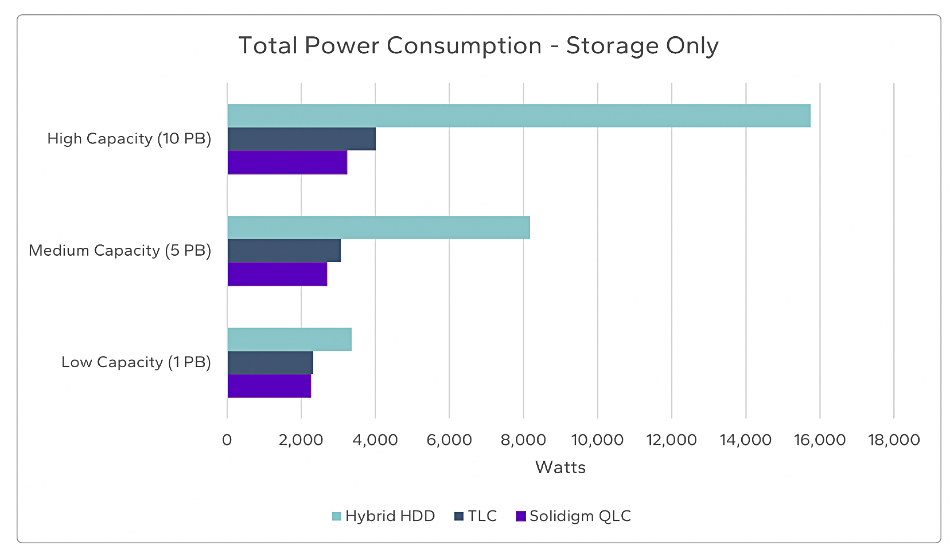
Overall, there was 79.5 percent greater power efficiency for QLC SSDs compared to hybrid TLC SSDs and HDDs. QLC SSDs also enabled 26.3 percent more total AI infrastructure within the datacenter. According to the report: “Although the three devices modeled have varying active power consumption values, with HDDs measuring the lowest for an individual drive, the high density QLC devices achieve the same total capacities with far fewer drives, resulting in lower overall power consumption.”
The report states: “The high density of QLC drives challenges the economic advantage of HDDs, while simultaneously offering flash performance, making them an attractive replacement for many typical HDD-based environments.”
On this basis, looking at capacity, performance, and electricity usage, it would seem crazy to build a nearline storage system using disk drives. The SSD-vs-HDD primary storage debate has already been won by flash. Witness the continuing conversion of NetApp’s installed ONTAP base to all-flash ONTAP systems. Witness also the use of DDN and VAST Data all-flash storage by xAI in its Colossus datacenter complex.
But now the all-flash suppliers are poised to break into the nearline storage market. Pure Storage has signed a deal with a top-four hyperscaler to supply both its all-flash nearline and primary storage technology. This involves Pure’s proprietary 75 and 150 TB flash drive designs and not commodity SSDs.
Micron, in its latest quarterly earnings call, made the point that it expects high-capacity commodity SSDs to start displacing capacity HDDs in the datacenter.
These indications support the Pure Storage thesis that flash drives will replace disk drives.
SSD cannibalization of disk drives
However, the disk drive industry has put out messaging that SSDs won’t replace disk drives because of three points identified by Seagate.
Firstly, SSD prices will not match spinning disk prices. Disk drives will retain a greater than 6:1 $/TB advantage over SSDs through to 2027. However, we can immediately recognize a contrasting viewpoint – that, although the acquisition cost of SSDs can be higher than HDDs, the total cost of ownership, which takes electricity usage and datacenter space into consideration, would favor SSDs, as in Solidigm’s report above.
Secondly, SSD fab capacity won’t match HDD fab capacity. TrendForce and IDC predict that 3,686 EB of combined NAND and HDD capacity will be needed in 2027. The NAND industry could build 963 EB of that with HDDs contributing 2,723 EB. Were that disk contribution to be replaced by NAND, the projected cost would be $206 billion. Seagate says this simply won’t happen by 2027.
Thirdly, SSDs are a bad fit for nearline disk workloads as this bulk of enterprise workloads doesn’t need SSD speed. Seagate’s use of the word “need” is interesting. If enterprises and hyperscalers can get that speed and make better use of their datacenter server infrastructure with SSDs, while saving on datacenter electricity and space costs as well, then they may very well say they “need” SSDs more than HDDs. Pure’s hyperscaler deal shows that this can happen.
The argument is not that SSD fab capacity can’t ever match that of HDDs, but that NAND fab capacity won’t match HDD by 2027. If there is a solid market opportunity for SSDs to replace nearline HDDs – 2,723 EB in 2027 using Seagate’s cited numbers – then the NAND fabbers will build more fab capacity over time, beyond 2027.
In the medium term, out to 2029, analysts like Tom Coughlin are forecasting that HDD unit and capacity sales will rise. Coughlin told us: “Yes, that is my assessment. SSDs will, in my opinion, not be competitive to HDDs for secondary storage with HAMR and other HDD announcements.”
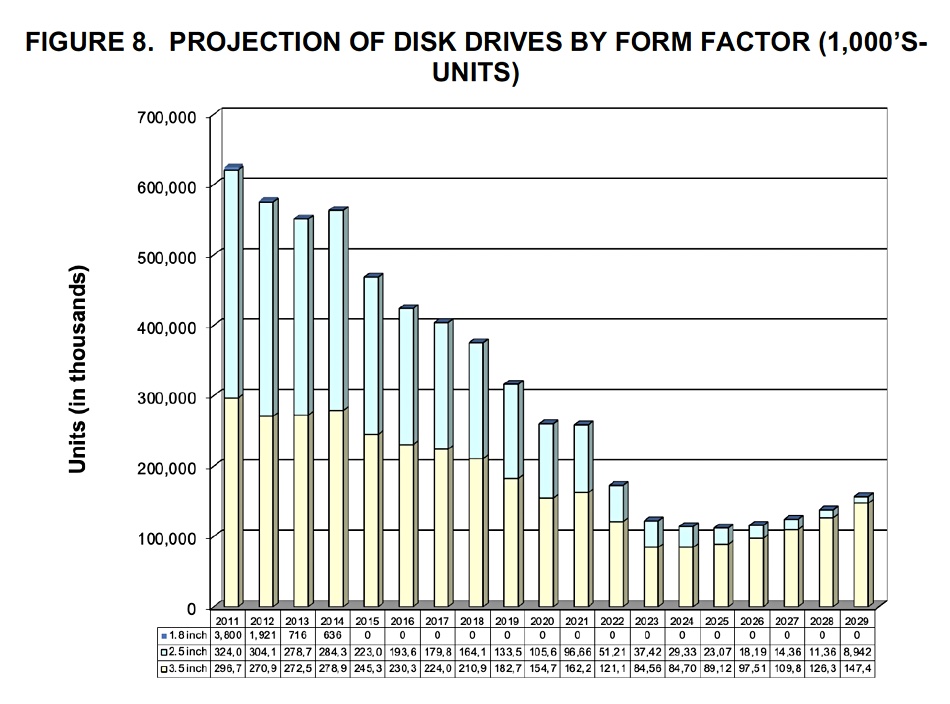
We could take the view that the market’s storage capacity needs will increase faster than SSD production capacity, and that SSD production capacity will be increased to catch up.
We think that the SSDs-will-cannibalize-nearline-HDDs argument will continue throughout 2025 as the 122 TB PCIe gen 5 SSDs come to market and real TCO numbers become available. The pro-SSD viewpoint will become stronger, encouraging analysts to change their point of view.
If market sentiment switches to favor SSDs then the implications for the three HDD manufacturers – Seagate,Toshiba, and Western Digital – are immense. Disk drives will be like film-based cameras facing digital cameras and then smartphone cameras. How did Kodak fare in this transition?
The three would face a long period of decline as SSDs eat into their nearline disk drive sales. We could then see Toshiba exiting from the HDD business, Seagate buying an SSD controller manufacturer to buttress its Nytro SSD product line, and WD even re-entering the SSD business by doing likewise. Against this line of thought, the prospects for FADU and Phison being acquired look excellent.



